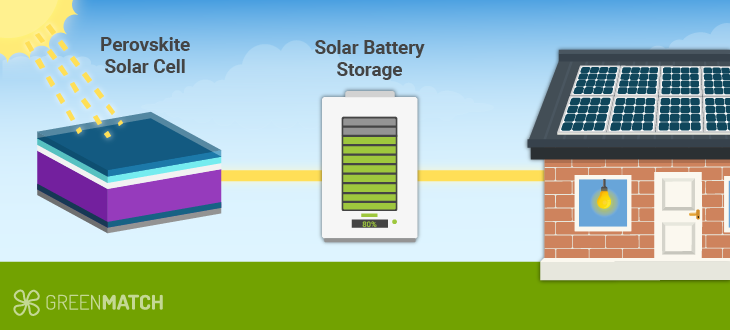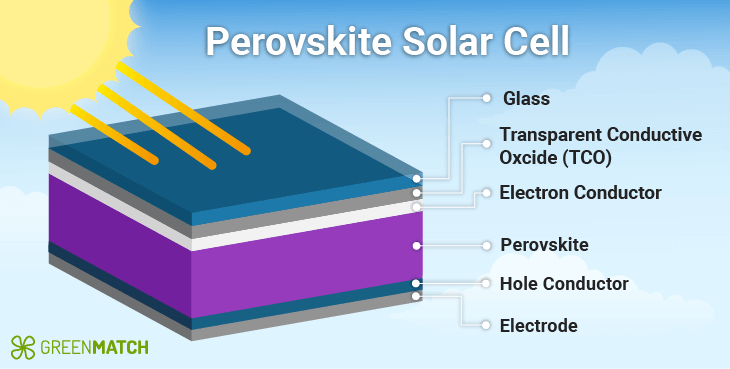Answer these simple questions and we will find you the BEST prices
Which type of solar quotes do you need?
It only takes 30 seconds
100% free with no obligation

Get up to 4 quotes by filling in only 1 quick form

Slash your energy bills by installing solar panels

For the average 2-3 bedroom house
- GreenMatch
- Blog
- Efficiency of Perovskite Solar Cells
Perovskite Solar Cells: Pioneering the Green Energy Revolution

The urgent need for sustainable and renewable energy solutions has never been more apparent; perovskite solar cells are emerging as the bright stars on the horizon. They emerged as a promising technology due to their potential for high efficiency, low production costs, and versatility. These solar cells have shown rapid progress, increasing efficiency rates from about 3% in 2009 to over 29% today.
Recent breakthroughs include producing perovskite solar panels, which promise to deliver cheaper and more efficient solar panels.
The remarkable solar panels for homes are rewriting the rules of the solar energy game, promising a future where clean and efficient power generation is not just a dream but a reality. This rapid development has made perovskite solar cells the fastest-advancing solar technology.
Perovskite solar cells lie in their ability to absorb light across almost all visible wavelengths, which allows them to convert more sunlight into electricity. They also offer flexibility, semi-transparency, tailored form factors, and lightweight properties, making them suitable for various applications.
Furthermore, perovskite solar cells can be combined with other photovoltaic materials like silicon to create tandem devices that achieve even higher efficiencies. This makes them ideal for integrating building materials, windows, and vehicles. Their thin and lightweight nature makes them attractive for space applications with materials that enable low-cost and scalable manufacturing.

What are perovskites?
Based on the perovskite research, results show that using perovskites has boosted solar panel efficiencies regarding the percentage of available sunlight that they convert to electricity. Researchers accomplish this more rapidly than any other solar cell material that has been mass-produced or is being developed in labs.
Analysts have examined these resources over the years. Their findings show that efficiency figures increased from 10 to 20 per cent in just two years.
Lev Perovski, a mineralogist, gave the name perovskites to a material called calcium titanium oxide. The perovskite compounds used to make solar cells are not calcium titanium oxide but share the same crystalline structure.
Scientists have created different compounds using minerals. One important compound contains methyl ammonium, lead, iodine, and chlorine, which can absorb a greater spectrum of sunlight than silicon. The material that makes up over 80 per cent of the solar cells on the market to
The emergence of perovskite solar panels
Perovskite solar panels are a game-changer primarily because of their remarkable efficiency in converting sunlight into electricity. Unlike traditional silicon-based solar panels, which have seen incremental improvements in efficiency over the years, perovskite solar cells have made a quantum leap.
Perovskite cells have achieved lab efficiencies surpassing 33%, a significant leap over traditional silicon cells. They have achieved efficiencies, approaching the theoretical limit for single-junction solar cells. This means they can generate more electricity from the same amount of sunlight, making them incredibly attractive for residential and commercial use.
The versatility of perovskite solar panels' design offers unparalleled flexibility. Manufacturers can incorporate them into various applications, including flexible and semi-transparent panels. This versatility opens doors to innovative uses, such as solar-integrated windows, building-integrated photovoltaics, and solar clothing.
Notably, advancements in material engineering and protective coatings have led to perovskite cells capable of enduring harsh conditions, with some designs projected to last up to 30 years.
Perovskite and its family of compounds
Perovskite is a compound family with a crystal structure similar to the mineral perovskite. These compounds, typically made from lead and halide elements, exhibit exceptional properties for solar energy conversion.
The crystalline structure of perovskite materials allows them to absorb a broad spectrum of sunlight efficiently. This characteristic is crucial for maximising energy conversion and increasing panel efficiency. Additionally, their tunable bandgap enables researchers to fine-tune their optical and electronic properties, making them highly adaptable to different environmental conditions.
Some perovskite materials have shown sensitivity to moisture and temperature. Researchers are exploring innovative approaches to overcome stability challenges in perovskite solar panels. These approaches include encapsulation techniques and alternative materials to ensure the long-term reliability of the technology.
Comparing Perovskite to traditional silicon-based solar panels
To truly appreciate the significance of perovskite solar panels, it's essential to understand how they compare to their conventional silicon-based counterparts.
Though silicon-based solar panels have dominated the photovoltaic industry for years, they have some limitations. Silicon requires high purity and a lack of structural defects, which increases production costs. The upper limit of efficiency for silicon has hovered at around 29%.
In contrast, perovskite solar cells have several advantages over silicon-based solar panels:
- Light absorption: Perovskite is much better at absorbing light across almost all visible wavelengths, allowing it to convert more sunlight into electricity.
- Tunability: Perovskite materials can be 'tuned' to use regions of the solar spectrum largely inaccessible to silicon photovoltaic systems.
- Flexibility and lightweight: Manufacturers can quickly deposit perovskite solar cells onto various surfaces, including flexible and textured ones. This property makes perovskite solar cells ideal for integration into building materials, windows, and even vehicles. Their thin and lightweight nature also makes them attractive for space applications.
- Low-cost and scalable manufacturing: The solution processability of perovskite materials enables low-cost and scalable manufacturing

Mass-producing perovskite solar cells
The best lab cell efficiency at present has reached 20%. However, making these cells efficient in mass production will require more years for perfection. This is because making a more significant number of cells with consistent quality is more complex than manufacturing a small quantity in the lab. The mass production of perovskite solar cells is predicted to emerge in the next couple of years, with the focus set on mass production.
One aspect to consider is the emergence of competition between the perovskite solar cell developers, who will have to compete in the price and efficiency of their products. More so than this, they must prove that their cells can last as long as the presently commercialised silicon cells. Experts predict companies will begin mass-producing perovskite solar cells within the next few years, focusing on scaling up production. Such obstacles require time, especially since silicon technology is relatively new and not entirely accepted worldwide.
Applications of perovskite solar cells
Perovskite solar cells, with their remarkable efficiency and versatility, are not just another innovation in renewable energy. Integrating these cells into various infrastructures and applications makes creating a more sustainable and efficient energy system possible.
Here are some ways to use panes to integrate perovskite solar cells into different infrastructures:
Building-integrated photovoltaics
One of the most exciting applications of perovskite solar cells is their integration into urban infrastructure, known as building-integrated photovoltaics (BIPV). BIPV seamlessly incorporates solar panels into the design of buildings, transforming them into power-generating structures. Unlike traditional bulky solar panels, perovskite solar cells can be flexible and transparent, offering architects and designers unparalleled creative freedom.
Integration with batteries and supercapacitors for energy storage systems
Researchers can integrate perovskite solar cells with energy storage devices like batteries and supercapacitors to create self-charging power packs. This combination allows for the efficient conversion and storage of solar energy in solar batteries, providing a sustainable and reliable power source. These integrated systems have potential applications in portable electronics, remote sensing, and other areas where energy autonomy is crucial.
Photovoltaic-driven catalysis
Perovskite solar cells can also be used in photovoltaic-driven catalysis, harnessing solar energy to drive chemical reactions. The unique properties of perovskites, such as high light absorptivity and tunable bandgaps, make them suitable for photocatalytic applications. Photovoltaic-driven catalysis has potential applications in solar-driven fuel generation, CO2 reduction, and other sustainable energy processes.
Advantages of perovskite solar cells
Solar energy has many advantages and disadvantages. Common metals and industrial chemicals can be used to make perovskite, unlike other silicon substitutes that require expensive raw materials.
Perovskite-based materials could also be used to print photovoltaic electronics directly onto glass or other materials. This would be cheaper than more complex methods for producing thin-film solar cells. As hybrid materials, perovskites boast good efficiencies and can be applied as a liquid solution, similar to organic solar materials.
Manufacturers can produce solar cells at high volumes and much lower costs than current silicon solar cells by spraying the perovskite as a liquid coating onto a substrate material.

The structure of the perovskite cells enables them to have high charge-carrier motilities and long diffusion lengths. This allows the photo-generated electrons to travel long distances without energy loss.
As a result, the electrons can travel through thicker solar cells, which absorb more light and generate more electricity than thin ones.
Alternating the compound composition allows the solar cell colour to be adjusted to any desired colour. This gives the cells the considerable advantage of being fabricated aesthetically. In addition, consumers may be willing to put them on their roofs as building-integrated photovoltaic applications become more attractive.
Manufacturers can process these materials as additional layers on top of silicon panels, where the colour modification improves the current state-of-the-art panels.
Building a perovskite solar system module capable of surviving for decades outdoors is currently still in its R&D phase, but what is certain is that the potential of perovskite solar cells is enormous. If the material’s promise can be realised, it could completely revolutionise the capabilities of solar energy.
Don't wait for perovskite solar cells to become available when you can save on your energy bills today with solar PV panels. Get up to 3 quotes from reliable installers and take the first step towards a more sustainable and cost-effective energy source.
- Quotes from local engineers
- Payment by finance available
- Save up to £1,110 per year
It only takes 30 seconds



Challenges and innovations perovskite solar panels
Perovskite solar cells have shown great potential in terms of efficiency and low production cost. However, their stability remains a significant challenge, as they are inherently vulnerable to moisture, high temperature, UV light, and other environmental factors.
Stability has been a recurring concern in the journey of perovskite solar panels. These stability issues have important implications for real-world energy yields and hinder the commercialisation of perovskite solar cells. Moreover, the panels have shown sensitivity to moisture, heat, and UV radiation, which can degrade their performance over time.
In addition, researchers are exploring innovative approaches to enhance the stability of perovskite solar panels. Encapsulation techniques, which protect the perovskite layers from environmental factors, show promise. Researchers are also experimenting with alternative materials and additives to improve resistance to degradation.
However, experts are optimising the interfaces between the perovskite absorber and charge transport layers to minimise losses and improve energy extraction. This optimisation aims to increase device efficiency and operational stability.
Furthermore, companies like Oxford PV are planning the commercial launch of their perovskite-on-silicon tandem cell, predicting a conversion efficiency of 27% and an increase in solar capacity in the coming years. In recent years, investments in perovskite R&D have been massive, with many believing that these materials will become game-changers in the solar market.
More collaborations between academic institutions, research organisations, and industry players are driving innovation and commercialisation efforts. For example, Saule Technologies, based in Poland, has developed a technology to produce perovskite PVs using inkjet printing. However, one key focus is helping perovskite photovoltaic companies overcome key technological hurdles.
Sustainable perovskite solar cell technology
Adopting perovskite solar panels is crucial for a more sustainable and greener future. As the cost of solar panels becomes more efficient and cost-effective, it can play a more prominent role in meeting global energy demands and reducing greenhouse gas emissions. These panels offer higher efficiency, lower production costs, and a versatile application solution.
Perovskite solar panels represent an investment in cleaner air, reduced carbon emissions, and a more resilient energy infrastructure. It aligns with global efforts to combat climate change and transition to renewable energy sources. It is a choice that benefits us and the planet we call home.
Additionally, perovskite solar cells can be combined with energy storage systems, such as batteries and supercapacitors. This synergy allows the system to store excess energy generated during the day and use it during the night or cloudy periods, ensuring a continuous and reliable power supply. Alternatively, selling back electricity to the grid when it can be stored is also an option. This creates a step toward a resilient and sustainable energy grid.
When Will perovskite solar panels be available?
The journey to making perovskite solar panels widely available is already underway as several companies are working on scaling up production and launching it in the market. While perovskite solar panels are available today, their full-scale adoption and integration into our cities and homes may take a few more years.
However, the progress made in recent years is promising, and the momentum is building. While the road ahead may have challenges, the promise of a brighter, more sustainable future powered by perovskite solar panels is worth every effort and investment.

Inemesit is a seasoned content writer with 9 years of experience in B2B and B2C. Her expertise in sustainability and green technologies guides readers towards eco-friendly choices, significantly contributing to the field of renewable energy and environmental sustainability.
We strive to connect our customers with the right product and supplier. Would you like to be part of GreenMatch?

